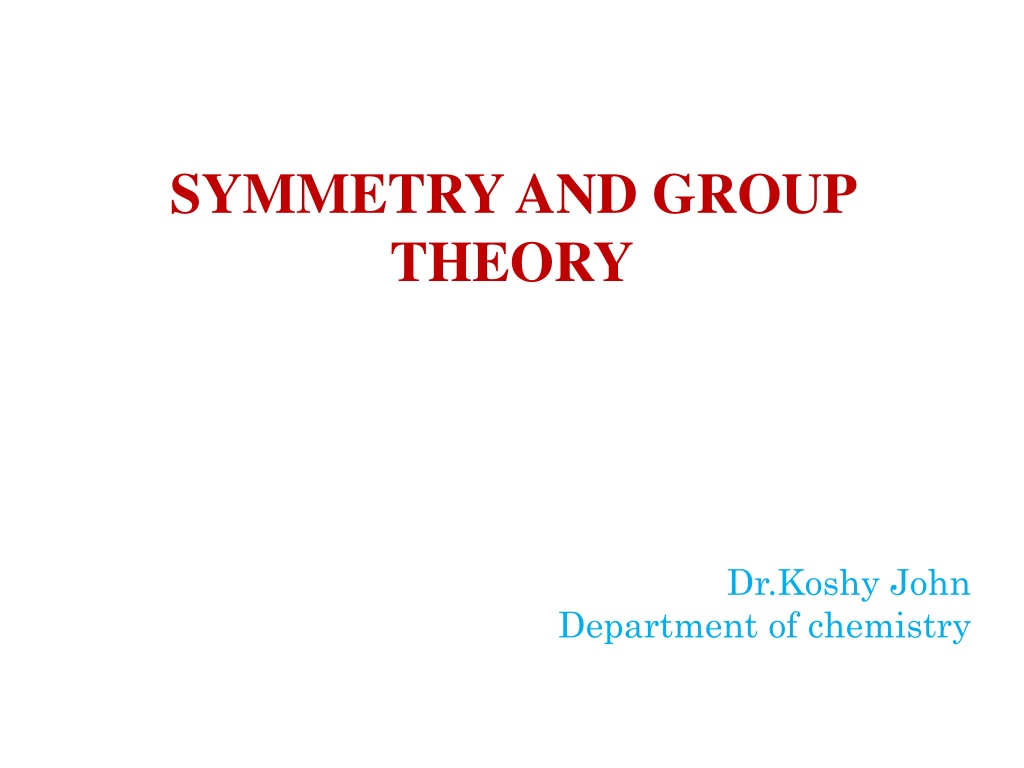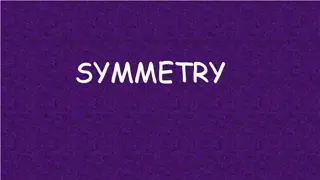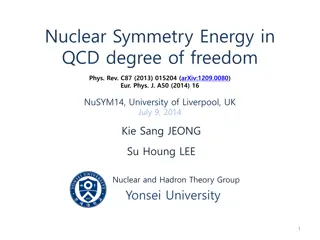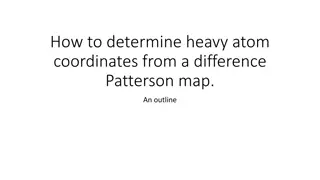Understanding Symmetry and Group Theory in Chemistry
Exploring the world of symmetry elements in molecules, encompassing identity, proper axis of symmetry, centre of symmetry, and plane of symmetry. Learn how these elements help in identifying the symmetry of molecules quantitatively, with examples like N2F2, H2O, C2H4, NH3, and Dichlorobenzene.
Download Presentation

Please find below an Image/Link to download the presentation.
The content on the website is provided AS IS for your information and personal use only. It may not be sold, licensed, or shared on other websites without obtaining consent from the author. Download presentation by click this link. If you encounter any issues during the download, it is possible that the publisher has removed the file from their server.
E N D
Presentation Transcript
SYMMETRY AND GROUP THEORY Dr.Koshy John Department of chemistry
Symmetry Elements The elements used to ascertain the symmetry of a molecule quantitatively is called Symmetry elements. A symmetry element is a geometrical entity such as a line about which a rotation is carried out, a point about which an inversion is carried out or a plane about which a reflection is carried out to generate an equivalent orientation or indistinguishable orientation. Elements of symmetry are; 1. Identity(E) 2. Proper axis of symmetry(Cn) 3. Centre of symmetry(i) 4. Plane of symmetry 5. Improper axis of symmetry
1.Identity Every object possess an identity element It s a doing nothing operation
2.Proper axis of symmetry An imaginary axis about which the molecule is rotated through an angle 360 /n to generate an equivalent orientation. It is an axis of n fold symmetry or an axis of order n. The highest order axis passing through maximum number of atoms is the principal axis. Water molecule has a 2-fold axis, Ammonia has a 3-fold axis and Boron trifluoride has a 3-fold and three 2-fold axes. H2O NH3 BF3
Molecule Principal axis C2 C3 C3 C4 C5 C6 C2 C4 Subsidiary axes Nil Nil 3C2 4C2 5C2 6C2 Nil Nil Water Ammonia BF3 XeF4 Cyclopentadienyl anion Benzene H2O2 XeOF4
3.Centre of symmetry(i) It is a point at the centre of the molecule from which lines are drawn in opposite directions will meet exactly similar points at exactly same distance. Molecules such as N2F2,C2H4,PtCl4,C6H6 etc contain i Objects possessing i are Sphere, Cube, Hexagon etc.
4.Plane of symmetry() A plane of symmetry is a plane which divides the molecule into two equal halves such that one half is the exact mirror image of the other half. Plane of symmetry can take up different orientations with respect to the principal axis. A plane which is perpendicular to he principal axis is denoted as v plane. Plane parallel to principal axis is h plane. A vertical plane which divides the the angle between two C axes is denoted as d plane. Number of planes of symmetry of a molecule can vary from one to infinity. Linear molecules have infinite number of planes.
Examples, N2F2 H2O C2H4 NH3 Dichlorobenzene
5.Improper axis of symmetry(Sn) It is an axis about which the molecule is rotated through 360/n followed by a reflection in a plane perpendicular to the axis produces an equivalent orientation Example N2F2
The various symmetry elements and operations are given below Symmetry elements Axis of symmetry Plane of symmetry Centre of symmetry Improper axis of symmetry Symmetry operation Rotation through an angle Reflection Inversion Rotation followed by reflection Schoenflies symbol Cn i Sn
Let us try to assign the point groups of some molecules now. Molecule Symmetry elements C3+3C2+ h C3+3C2+ h C2+2C2+ h C3+3C2+ h C3+3C2+3 d C2+2C2+2 d C6+6C2+ h C4+4C2+ h C + v C + C2+ h C2+2 v C3+3 v 4C3+3C2+6 d 4C3+6C2+3C4+3 h Point group D3h D3h D2h D3h D3d D2d D6h D4h C v D h C2v C3v Td Oh BF3 PF5 Ethylene Ethane(Eclipsed) Ethane(staggered) Allene Benzene XeF4 HCl H-H CH2Cl2 CH3Cl CH4 SF6























